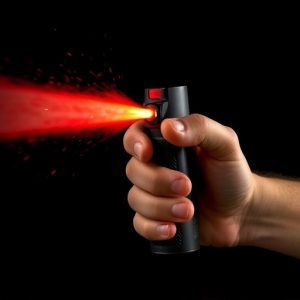How to Respond and Recover from Pepper Spray Exposure
TL;DR:Exposure to pepper spray requires swift action for effective treatment. Key steps include imme…….
TL;DR:
Exposure to pepper spray requires swift action for effective treatment. Key steps include immediately moving to fresh air, flushing affected eyes and skin with water for 15 minutes, removing contaminated clothing, using cold compresses, and seeking medical attention if symptoms persist or worsen. Preventive measures focus on staying alert, maintaining awareness of surroundings, and having a personal safety plan. Prompt action after exposure is crucial for mitigating discomfort and ensuring swift recovery.
“Aerosol spray defense has become a vital skill in today’s unpredictable world, offering a crucial tool against potential attackers. This comprehensive guide delves into the effectiveness of pepper spray as a deterrent and treatment method. Understanding its composition and immediate response strategies can save lives. We explore how to manage exposure across various body parts, provide first aid, and offer preventive measures to avoid such incidents. Discover essential tips on ‘How to Treat Pepper Spray Exposure’ – from preparation to recovery.”
- Understanding Pepper Spray: Its Composition and Effects
- Immediate Response: What to Do After Exposure
- Treating Different Parts of the Body Affected by Pepper Spray
- Preventive Measures: Preparing for and Avoiding Pepper Spray Attacks
Understanding Pepper Spray: Its Composition and Effects
Pepper spray, an aerosol defense mechanism, contains capsaicin, the active ingredient found in chili peppers. When sprayed, it irritates the eyes, nose, and respiratory system, causing temporary blindness, coughing, and difficulty breathing. This disruption enables the user to escape or defend themselves against attackers.
Understanding how pepper spray works is crucial when knowing How to Treat Pepper Spray Exposure. Inhalation can lead to severe irritation, so immediate steps include removing contaminated clothing, washing eyes with water for at least 15 minutes, and seeking fresh air. Medical attention may be required if symptoms persist or worsen, ensuring swift recovery and minimizing long-term effects.
Immediate Response: What to Do After Exposure
After exposure to aerosol spray, such as pepper spray, a swift and appropriate response is crucial for minimizing discomfort and ensuring safety. The initial steps involve quickly moving to a safe location away from the attacker and any lingering spray particles. This distance will help reduce direct eye irritation and respiratory distress.
Next, flush the affected areas with ample water for at least 15 minutes. For facial exposure, thoroughly rinse eyes, nose, and mouth under running water. If clothing is contaminated, remove them promptly to prevent further skin contact. Applying a cold compress or ice pack can help soothe any burning sensations and reduce swelling. Seek medical attention if symptoms persist, as some individuals may require prescription medications to manage the effects of pepper spray exposure.
Treating Different Parts of the Body Affected by Pepper Spray
If pepper spray comes into contact with your eyes, it can cause intense irritation and temporary blindness. In case of eye exposure, immediately flush the affected area with plenty of water for at least 15 minutes. Seek medical attention if irritation persists or if there are signs of severe damage, such as changes in vision.
For skin exposure, wash the affected areas with mild soap and warm water. Avoid using harsh chemicals or alcohol-based products that could further irritate the skin. If pepper spray is inhaled, move to an area with fresh air immediately. If symptoms like coughing, difficulty breathing, or chest tightness persist, seek medical help as soon as possible.
Preventive Measures: Preparing for and Avoiding Pepper Spray Attacks
Preventive Measures: Preparing for and Avoiding Pepper Spray Attacks
Knowing how to prepare for and avoid pepper spray attacks is crucial for enhancing personal safety. One of the best defenses against aerosol spray is prevention. Staying alert and aware of your surroundings can significantly reduce the risk of an attack. When in public spaces, keep a safe distance from strangers and be cautious in poorly lit or secluded areas known for increased crime rates. Regularly updating your personal safety plan and staying informed about potential threats in your neighborhood are essential steps.
Should you find yourself facing a pepper spray attack, understanding how to treat exposure immediately becomes critical. If exposed, quickly move to a safe location away from the attacker. Remove any contaminated clothing or accessories, flush affected areas with water for at least 15 minutes, and seek fresh air. It’s also advisable to wash your face and eyes gently to remove any residual spray. Prompt treatment can help alleviate symptoms and ensure faster recovery.
Understanding how to treat pepper spray exposure is crucial for navigating potential attacks. By quickly recognizing symptoms, taking immediate action, and knowing effective treatment methods for different body parts affected, individuals can mitigate the impact of aerosol spray defense. Additionally, implementing preventive measures will significantly reduce the risk of exposure in the first place. Remember, knowledge is a powerful tool in self-defense, so be prepared and stay safe.


